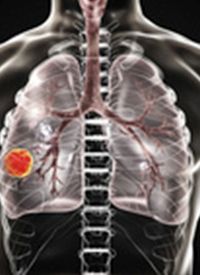Article
Larotrectinib Demonstrates Favorable Long-Term Responses in NTRK Fusion–Positive Lung Cancer
Author(s):
Larotrectinib continued to elicit durable responses and a low toxicity profile in patients with NTRK fusion–positive lung cancer, according to long-term follow-up data from the phase 2 NAVIGATE trial and phase 1 LOXO-TRK-14001 trial.

Larotrectinib (Vitrakvi) continued to elicit durable responses and a low toxicity profile in patients with NTRK fusion–positive lung cancer, according to long-term follow-up data from the phase 2 NAVIGATE trial (NCT02576431) and phase 1 LOXO-TRK-14001 trial (NCT02122913) presented at the IASLC 2022 World Conference on Lung Cancer.1
Investigators observed an objective response rate (ORR) of 83% (95% CI, 61%-95%) in 23 evaluable patients with NTRK fusion–positive disease. The 24-month progression-free survival (PFS) rate was 67% (95% CI, 44%-90%) while the 24-month overall survival (OS) rate was 72% (95% CI, 48%-97%).
“Larotrectinib demonstrated rapid and durable responses, extended survival, and a favorable long-term safety profile in patients with advanced lung cancer harboring NTRK gene fusions,” the investigators stated in their poster.
The NAVIGATE and LOXO-TRK-14001 trials included patients with fusions in the NTRK1, NTRK2, and NTRK3 genes. Patients with cancer types including lung, thyroid, salivary, and colorectal cancers were enrolled on these trials, but this analysis included only those with advanced lung cancer. Both trials administered larotrectinib at a dose of 100 mg twice daily. The primary end point was ORR.
Larotrectinib was also investigated as an NTRK inhibitor in the phase 1/2 SCOUT trial (NCT02637687). Across all 3 trials and disease types, this drug exhibited an overall response rate of 75% (95% CI, 61%-85%) by independent review committee (IRC) and 80% by investigator assessment (INV) in 55 patients with predominantly grade 1 adverse events (AEs).2 In 2018, based on SCOUT, NAVIGATE, and LOXO-TRK-14001, it was approved by the FDA for all solid tumors harboring an NTRK fusion in adults and children with metastatic disease or those who cannot receive surgery and have no satisfactory alternative treatments.3
At the previous data cutoff of July 20, 2020, 15 patients with advanced lung cancer were evaluated, with an ORR of 87% as assessed by an IRC and 73% by INV.4 With an additional year of follow-up, the ORR was still 87% by IRC, termed Group 1 in this analysis.1 They also presented data for Group 2, which consisted of these 15 plus an additional 11 patients. Both groups were evaluated at a data cutoff of July 20, 2021.
For Group 1, the median DOR was not reached; the median PFS was 33.0 months; and median OS was 40.7 months at a median follow-up of 24.0, 35.8, and 35.8 months, respectively.
Investigators found that of the 23 evaluable patients in Group 2, there were 2 complete responses, 17 partial responses (PR), and 4 patients with stable disease (SD). No patients had progressive disease. The median PFS and DOR in all 26 patients were not reached, while the median OS was 40.7 months (95% CI, 19.4–not estimable [NE]). The 24-month rate of DOR was 72%. The median follow-up for DOR was 12.9 months, while for PFS it was 14.6 months and for OS it was 12.9 months.
When including all 26 patients, the median age was 51.5 years (range, 25.0-76.0). Patients had received a median of 2 prior therapies (range, 0-6), with 46% having received 3 or more prior therapies.
Ten evaluable patients had baseline central nervous system metastases. They had an ORR of 80% (95% CI, 44%-97%) including 8 PRs and 2 with SD. For these patients, the median DOR was 9.5 months (95% CI, 3.6–NE), while the median PFS was 9.9 months (95% CI, 5.3–NE), and the median OS was 19.4 months (95% CI, 7.6–NE) at a median follow-up of 9.3, 11.0, and 12.0 months, respectively.
There were no new safety signals for Group 1, which previously reported mainly grade 1 and 2 AEs. Group 2 also reported mainly grade 1 and 2 treatment-related AEs. The most common treatment-related AEs included elevated alanine aminotransferase and aspartate aminotransferase (AST) levels (38.5% and 30.8%, respectively), followed by myalgia (26.9%) and constipation (23.1%). The most common grade 3 or higher AEs related to larotrectinib were increased AST (7.7%) and weight gain (7.7%). No patients discontinued treatment due to AEs.
These results confirm the long-term response and efficacy of larotrectinib in patients with advanced lung cancer who are identified as harboring NTRK fusions. “These results support testing for NTRK gene fusions in patients with lung cancer,” the investigators concluded in their poster.
References
- Moreno V, Lin JJ, Tan DSW, et al. Extended follow-up of efficacy and safety of larotrectinib in patients with TRK fusion lung cancer. Presented at: IASLC 2022 World Conference on Lung Cancer; August 6-9, 2022; Vienna, Austria. Abstract EP08.02-148.
- Drilon A, Laetsch TW, Kummar S, et al. Efficacy of larotrectinib in TRK fusion-positive cancers in adults and children. N Engl J Med. 2018;378(8):731-739. doi:10.1056/NEJMoa1714448
- FDA approves larotrectinib for solid tumors with NTRK gene fusions. FDA. December 14, 2018. Accessed August 4, 2022. https://bit.ly/3Sve4AX
- Drilon A, Tan DSW, Lassen UN, et al. Efficacy and safety of larotrectinib in patients with tropomyosin receptor kinase fusion-positive lung cancers. JCO Precis Oncol. 2022;6:e2100418. doi:10.1200/PO.21.00418









